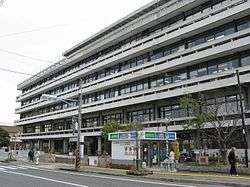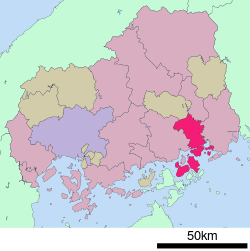Onomichi, Hiroshima
Onomichi (尾道市, Onomichi-shi) is a city located in Hiroshima Prefecture, Japan, facing the Inland Sea. The city was founded on April 1, 1898.
Onomichi 尾道市 | |
|---|---|
 Onomichi City Hall | |
 Flag  Emblem | |
 Location of Onomichi in Hiroshima Prefecture | |
 Onomichi Location in Japan | |
| Coordinates: 34°25′N 133°12′E | |
| Country | Japan |
| Region | Chūgoku (San'yō) |
| Prefecture | Hiroshima Prefecture |
| Government | |
| • Mayor | Yuko Hiratani |
| Area | |
| • Total | 284.85 km2 (109.98 sq mi) |
| Population (April 30, 2016) | |
| • Total | 141,811 |
| • Density | 497.8/km2 (1,289/sq mi) |
| Symbols | |
| • Tree | Sakura |
| • Flower | Sakura |
| Time zone | UTC+9 (JST) |
| City hall address | 1-15-1 Kubo, Onomichi-shi, Hiroshima-ken 722-8501 |
| Website | www |
As of April 30, 2016, the city has an estimated population of 141,811 and a population density of 497.8 persons per km². The total area is 284.85 km².
It is well known for being featured in the 1953 film Tokyo Story, as well as in the 1960 film The Naked Island.
History
- 1168: The city's port opened and for the next 500 years served as a rice shipment center and port for all trades with foreign countries. Its commercial significance somewhat wavered during the Tokugawa period.
- 1898: Onomichi Town in Mitsugi District becomes the second city in Hiroshima Prefecture.
- 1935: The RMS Adriatic was scrapped in Onomichi.
- 1937: The town of Kurihara and the village of Yoshiwa, both in Mitsugi District incorporated.
- 1939: The village of Sanba from Numakuma District incorporated.
- 1951: The village of Fukada from Mitsugi District incorporated.
- 1954: Three villages from Mitsugi District incorporated.
- 1955: Three villages from Numakuma District incorporated.
- 1957: The village of Urasaki from Numakuma District incorporated.
- 1970: The town of Mukaihigashi from Mitsugi District incorporated.
- March 28, 2005: The towns of Mitsugi and Mukaishima (both from Mitsugi District) were merged into Onomichi.
- January 10, 2006: The towns of Innoshima and Setoda (both from Toyota District) were merged into Onomichi.
Tourism
The city is known for its many temples such as the Buddhist Senkō-ji Temple (founded in the 9th century), has a shipbuilding yard and a motor factory. It offers a steamship service to ports of northern Shikoku and islands in the Inland Sea.[1]
Temples
- Senkō-ji – Chūgoku 33 Kannon Pilgrimage No. 10[2]
- Kōmyō-ji[3]
- Tennei-ji[4]
- Jōdo-ji – Chūgoku 33 Kannon Pilgrimage No. 9[5]
- Saigō-ji
- Saikoku-ji – Chūgoku 33 Kannon Pilgrimage[6]
- Kongō-ji
- Kōsan-ji in Setoda, Hiroshima[7]
- Kōjō-ji in Setoda – Chūgoku 33 Kannon Pilgrimage No.11[8]
- Jikō-ji[9]
- Kaifuku-ji
- Jōsen-ji
- Syōjyu-in
- Jikan-ji
- Myōsen-ji
- Taisan-ji
Castles
- Innoshima Suigun Castle[11]
- Onomichi Castle
- Fukuyama Domain Bansho Ato
Parks and gardens
- Senkoji Park on Mt. Senkoji – connected by Senkōji Ropeway from Onomichi Station
- Senkoji Park Green Land (1965–2007)
- Bingo Regional Sports Park
- Onomichi Shimanami Baseball Stadium – NPB game held twice a year as Hiroshima Carp home game.
- Mukaishima Orchid Center
- Innoshima Flower Center
- Citrus Park Setoda
- Innoshima Ohashi Memorial Park
- Mt. Takami National Park
- Tachibana Nature Village
- The Island's Blooms – The Pyrethrum[12]
- Hyakka Park
- Souraiken Garden
- Mitsugi Greenland
- Marine Youth Center
- Mitsugi Softball Ballpark
- Chojabara Sports Center
- Mukaishima Sports Park
- Innoshima Sports Park
- Innoshima Amenity Pool
- Kaibutsu-en Ato (The remains of Kaibutsu-en) – The garden of the House of Tomishima (Tenmaya)
Museums
- Onomichi City Museum of Art
- Ikuo Hirayama Museum of Art – by named after Ikuo Hirayama
- Musee Nakata
- Onomichi Literature Museum
- Entsuba Katsuzo Sculpture Museum
- Honinbo Shusaku Igo Memorial Museum – by named after Honinbo Shusaku
- Museum of Setoda History and Folklore
- Onomichi Historical Museum
- Innoshima History Museum
- Island-Wide Art Museum
- Onomichi Motion Picture Museum
Beaches
- Shimanami Beach
- Ohamasaki Camp Site
- Setoda Sunset Beach
- Setoda B & G Marine Center
- Tachibana Beach
- Iwashijima Beach on Iwashijima Island
Hot springs
- Natural Spa Onomichi Fureai no Sato
- Mitsugi Yu Yu-Kan
- Harada-cho Yujin Hot spring
- Yoro onsen
Others
- Literature Path
- Nishiseto Expressway – "Shimanami Expressway" connects Onomichi and Imabari, Ehime
- Innoshima Suigun Skyline
- Kaneyoshi Bus Stop
- Statue of Fumiko Hayashi
- Onomichi City Library
- Tsureshio Stone Monuments
- Shimanami Koryu-kan – "Teatro Shell-rune"
- Bel Canto Hall
- Crossroad Mitsugi
Economy
Manufacturing
Shipbuilding
- Naikai Shipbuilding
- Mukaishima Dock
- Onomichi Dockyard
- Universal Shipbuilding Onomichi dock
- Hitachi Zosen Corporation Onomichi dock
- JFE Shoji Trade Shipbuilding
Metalworking
- Press Kogyo
- Union Plate Onomichi plant
Chemistry
- Nitto Denko Onomichi plant
- Yokohama Rubber Company Onomichi plant
Agriculture
Media
- Onomichi FM
- Onomichi Cable Television
Bookselling
- Keibunsha
Crime and safety
The Kyodo-kai yakuza syndicate is based in Onomichi.[13] The Kyodo-kai is the second largest yakuza group in the Chugoku region after the Hiroshima-based Kyosei-kai.[14]
In popular culture
The city is featured in the Japanese film Tokyo Story (1953) directed by Yasujirō Ozu. It is the setting for the fantasy 2005 anime series Kamichu! which faithfully depicts many of the city's features and landmarks. Events of the Blue Drop series also happen in this city. It is also the setting of the romantic manga Pastel by Toshihiko Kobayashi. The video game Yakuza 6: The Song of Life heavily features Onomichi as an in-game location, and its fictional mascot, Ono-michio.
Books
- A Dark Night's Passing (1921) by Naoya Shiga
- Horoki (1930) by Fumiko Hayashi
- Akumyo (1961) by Toko Kon
Films
- Tokyo Story by Yasujirō Ozu (1953)
- Films by Kaneto Shindō
- Kanashimi wa onna dakeni (1958)
- The Naked Island (1960)
- Akumyo series by Tokuzo Tanaka, Kazuo Mori, Kimiyoshi Yasuda, Masahiro Makino, Yasuzo Masumura, Seiji Izumi (1961–2001)
- Nikui an-chikushô by Koreyoshi Kurahara (1962)
- Boy by Nagisa Oshima (1969)
- Films by Nobuhiko Obayashi
- Exchange Students (1982)
- The Little Girl Who Conquered Time (1983)
- Lonely Heart (1985)
- Chizuko's Younger Sister (1991)
- Goodbye for Tomorrow (1995)
- One Summer's Day (1999)
- His Motorbike, Her Island (1986)
- Bound for the Fields, the Mountains, and the Seacoast (1986)
- The Stupid Teacher (1998)
- Yamato by Junya Sato (2005)
Drama
- Teppan (2010)
Manga
- Hikaru no Go (1998–2003)
- Parallel (2000–2002)
- Pastel (2002–2017)
- Shimanami Tasogare by Yuhki Kamatani (2015–2018)
Video games
- Yakuza 6: The Song of Life (2016)
- Between the Sky and Sea (2017–2019)
Notable people
Musicians
Go players
Sports
Authors/artists
Voice Actor
Sister cities
Onomichi has Sister City relationships with:





See also
References
- Hoffart, Jackie, "Nice to nestle at Japan's hometown", The Japan Times, 3 October 2008, p. 24.
- Senkoji Temple (English)
- Komyobo Temple (English)
- Tenneiji Temple (English)
- Jodoji Temple (English)
- Saikokuji Temple (English)
- Kosanji Temple (English) Archived 2011-07-21 at the Wayback Machine
- National Treasure Kojoji Temple (English)
- Jikoji Temple (English)
- Misode Shrine in English
- Onomichi City Tourist Spots (English)
- Onomichi City Tourist Spots (English)
- "2010 Police White Paper Chapter 2 : Furtherance of Organized Crime Countermeasures", 2010, National Police Agency (in Japanese)
- "The Second Kyodo-kai", 20 February 2008, Matsue Joho Center (in Japanese)
External links
| Wikimedia Commons has media related to Onomichi, Hiroshima. |
| Wikivoyage has a travel guide for Onomichi. |
- Onomichi City official website (in Japanese)
- Onomichi City official website (in English)
- Onomichi's Coordinator for International Relations website (in English)
